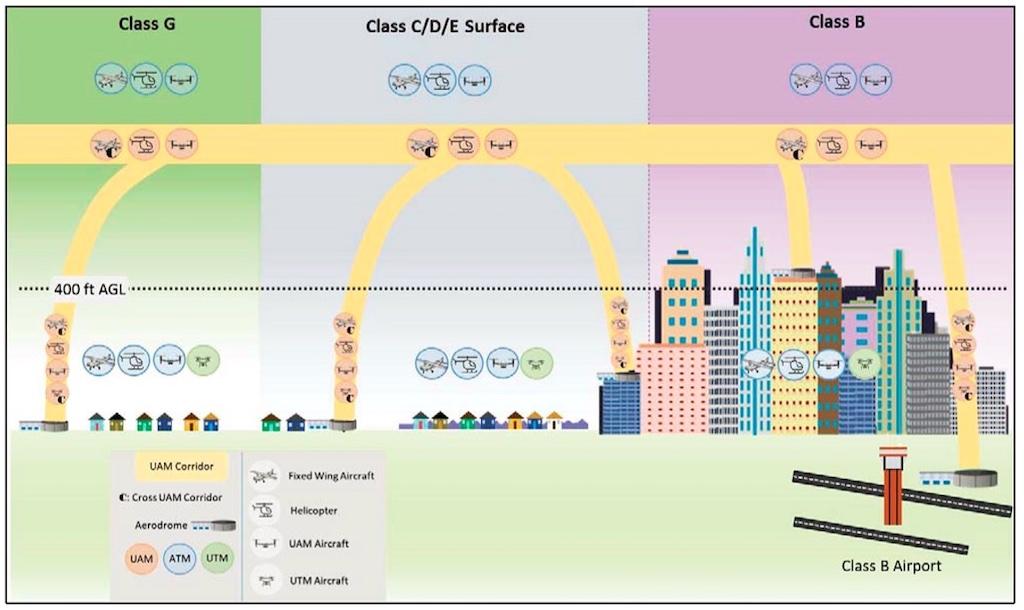
AAM infrastructure will require continuous electrical supply and capacity to support regular operations by battery-powered aircraft, demands that could recalibrate FBO relationships with utility companies and nearby communities sharing the power grid. The number of chargers the grid can support is dependent on the specific location and existing infrastructure, ground side developers say.
“Something that our industry needs to start looking at immediately is the grid,” says Katy Glynn, an account executive for the energy and performance division of Siemens Smart Infrastructure. “We’re looking at different aircraft; we’re looking at air safety; we’re talking about all of the essential things. But something we can start talking about right now is what do we need to do to enable the grid to handle this additional load and avail that power where it is going to be needed?”
Whereas current developmental AAM vehicles charge at around 350-500 kw (the Eviation Alice has an 820-kw-hour battery system), EUROCAE is developing a 1 megawatt-per-aircraft charging standard to support rapid recharging of batteries. Certain areas in the U.S. could supply 1 megawatt with no problem, although others could be challenged, says John Kasuda, director of strategic projects with Siemens, a supplier of building electrification and control systems.
Automotive Synergies

Siemens is supplying a custom electric vehicle charger for the new Ford F-150 Lightning electric pickup truck. The Ford Charge Station Pro has a peak power of 19.2 kw. At peak charging power, the F-150 Lightning with extended-range battery “means a full charge from 15-100% in about 8 hr.,” according to Ford. The automaker is reportedly developing a high-speed charging cable for electric aircraft.
“A lot of our expertise is coming through us being able to provide these stations for cars, trains and buses,” Kasuda says. “I would say the bus model is probably going to be the closest to these [AAM] vehicles because these vehicles will have relatively large power draws. The recharging becomes important because of the way they want to cycle these vehicles. You’re in essence trying to maintain enough charge on the battery to get it through the day, then at some point, you pull it offline and put it on a charger.
“There exist technologies today [for] megawatt capacity power levels that offer very fast charging for very large battery packs,” Kasuda advises. “We’re going to get better and better at these fast-charging stations, particularly at the higher level.”
During the unveiling of the Volatus Infrastructure vertiport at Wittman Regional Airport in March, company cofounder Grant Fisk exuded confidence in the capacity of the local electrical grid to support eVTOL operations in Oshkosh. “The way the commercial power grid is set up it can usually handle the power needs for these,” Fisk says. “If we need to install, say, 20 chargers, then we may have to figure it out. But if we’re just talking about two, four, 10 chargers, the power grid as it exists will be able to handle it no problem.”
Skyports’ Addison Ferrell, head of Americas, estimates that a vertiport supporting “a FATO plus multiple gates” would have a power requirement of 2-5 megawatts. “There are various factors, the two biggest of which are the size of the vertiport and the draw expected from the aircraft that will be using it,” he says. “Rough order of magnitude, we would expect the power capacity needed to run a vertiport to range from 2 megawatts up to around 5 megawatts on the high end. If it needs to be less than that for whatever the reason may be, it’s going to [mean] slower charging, a longer time for the aircraft at the gate and less throughput.”
Beta Technologies says the Alia-250 will be able to charge in less than an hour after a typical mission using a 300-500 kw charger. “Our chargers use a smart, dynamic charging profile to minimize impact to the grid while still delivering charge safely and efficiently,” the startup says. “In areas where existing infrastructure or utilities are sparing, we’re able to leverage existing resources, like integrating on-site solar production and battery energy storage.”
Airspace Considerations

An important consideration for AAM infrastructure developers is the airspace environment that will envelop future vertiports. In the U.S., the NASA Aeronautics Research Mission Directorate has spearheaded work on AAM airspace integration in collaboration with the FAA and industry. Regulatory processes initiated by the FAA and the European Union Aviation Safety Agency (EASA) address airspace operating aspects such as FATO dimensions, orientation, lighting and markings.
EASA released a guidance document in March, “Prototype Technical Specifications for the Design of VFR Vertiports,” that describes the physical characteristics, required obstacle environment, and visual aids, lights and markings of an operating site for VTOL-type aircraft. The document introduces the concept of an “obstacle-free volume,” a funnel-shaped area above a vertiport tailored to the operational capabilities of AAM aircraft.
The European agency says its next step will be to develop “full-spectrum” regulatory requirements for vertiports to include detailed design specifications, requirements for authorities overseeing vertiports and requirements for vertiport operators.
The FAA in March issued draft Engineering Brief 105 providing design guidance for vertiport and “vertistop” construction supporting eVTOL aircraft. The agency aims to publish a final EB 105 for vertiport design later this year after evaluating public comments.
“Right now, the FAA has not indicated that they are looking to change infrastructure or add new infrastructure in terms of airways or airspace changes,” the NBAA’s Heidi Williams says. “At some point, as you see these operations scale up, we’re going to have to rethink [that]. We’re operating in an airspace environment that has been utilized for decades. It did not necessarily take into account emerging technologies like [uncrewed] or eVTOL type of aircraft that may be more densely populated in what we have termed as uncontrolled airspace today.”
Williams observes that AAM vehicles potentially will cross through controlled and uncontrolled airspace, including flying within the Mode C veil surrounding major airports where aircraft must be equipped with transponders and two-way communications. “I think we are going to have to take a fresh look at that,” she says.
AAM On The Ground, Part 1: https://aviationweek.com/business-aviation/airports-fbos-suppliers/aam-…
AAM On The Ground, Part 2:https://aviationweek.com/business-aviation/airports-fbos-suppliers/aam-…





